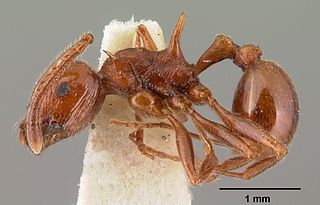
Anoplolepis, also known as the "pugnacious ants", is a genus of ants in the subfamily Formicinae and tribe Lasiini. The genus is mainly found in the Afrotropics, with a few native species known from the Malagasy and Oriental regions.

Harpagoxenus is a genus of ants in the subfamily Myrmicinae. Found in the Palaearctic and Nearctic ecozones of the world, Harpagoxenus was first established as Tomognathus by Mayr (1861) to house the species Myrmica sublaevis. However, the name had already been used (homonym) for a genus of fish, and was replaced with its current name by Forel (1893).

Gracilidris is a genus of dolichoderine ants with nocturnal behaviour; thought to have gone extinct 15-20 million years ago, they have been found in Paraguay, Brazil, and Argentina and were described in 2006.

Diacamma is a genus of queenless ants belonging to the subfamily Ponerinae. It is distributed from India to Australia and contains about 24 species.

Cryptopone is a genus of ants in the subfamily Ponerinae. The genus has a worldwide distribution, with most species occurring in Asia. Workers range from very small to medium in size (1.7–6.1 mm), with the queens being slightly larger.

Myrmicocrypta is a Neotropical genus of fungus-growing ants in the subfamily Myrmicinae. The genus is known from Mexico to Argentina. Their colonies are generally small, consisting of fewer than 200 individuals.

Philidris is a genus of ants in the subfamily Dolichoderinae. The genus is known from tropical forests from eastern India to northern Australia. It is similar to the genus Iridomyrmex, from where the type species was transferred from by Shattuck (1992).

Lordomyrma is a genus of ants in the subfamily Myrmicinae.

Huberia is a genus of ants in the subfamily Myrmicinae. The genus contains two species endemic to New Zealand.

Acanthomyrmex is a genus of ants in the subfamily Myrmicinae. The genus is known from South East Asia. Its species are dimorphic, with major workers in some genera having heads twice the length than that of the minor workers. They live in small colonies and are rarely collected in the field. There are 17 species of Acanthomyrmex.

Pristomyrmex is a genus of ants in the subfamily Myrmicinae.

Paratopula is a genus of ants in the subfamily Myrmicinae. The genus consists of arboreal species known from the Oriental and Indo-Australian regions. Little is known about their biology.

Gesomyrmex is a genus of ants in the subfamily Formicinae. The genus contains six extant species, known from the Indomalayan realm, and nine fossil species. Of the extant species, four are known only from workers and two only from females. The extinct species "G. expectans" and "Gesomyrmex miegi", formerly placed in the genus, were excluded by Dlussky et al.., 2009.

Prolasius is a genus of ants in the subfamily Formicinae. Of the genus' 19 species, 18 are known from Australia and one from New Zealand. They nest in soil under rocks or logs, sometimes in trees.

Notoncus is an Australian genus of ants in the subfamily Formicinae. The genus is known from Australia, where the ants nest in the soil or on the ground under stones and logs in forested areas. The ants are also common in gardens and parks.

Streblognathus is a genus of ants in the subfamily Ponerinae. The genus contains two species found in southern Africa.

Paraponera is a genus of ants and the only genus in the subfamily Paraponerinae. The name means "near-Ponera".

Myopopone castanea is a species of ant in the genus Myopopone. It was described by Smith in 1860.
Myopopone sinensis is an extinct species of ant in the genus Myopopone. Fossils were discovered in 1989 in China, and was later described by Zhang in that year.


















